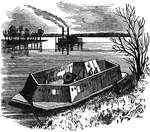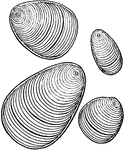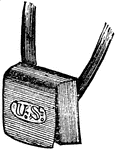Clipart tagged: ‘shells’

Iphigenia Brasiliensis - Sinupalliate Right Valve
"Having a sinuous pallial margin and consequent sinuous impression on the shell along the line of attachment…
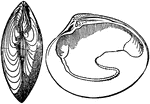
Bivalve
Shell of a bivalve, those mollusks whose coverings consist of two concave shelly plates or valves.

40 Pound Mortar Stick Bomb Shell
An illustration of a 40 pound mortar stick bomb shell. The shell have three wings, or vanes, around…

99 Pounds Mortar Stick Bomb Shell
An illustration of an early 99 lb. stick bomb used in a mortar. This bomb had vanes, or wings, around…
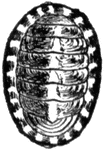
Chiton
Chiton is a peculiar marine mollusk. It is low and flat, creeping like the limpets. But the shell consists…

Chrysalidina Gradata
This illustration shows the calcareous shell Chrysalidina gradata. These shells are mostly very small,…
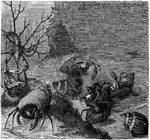
Hermit Crabs
An illustration of hermit craps shedding their shells and finding new ones. As hermit crabs grow they…
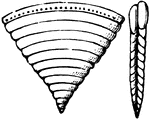
Cuneolina Pavonia
This illustration shows the calcareous shell Cuneolina pavonia. These shells are mostly very small,…
Divider with Star Pattern
This divider features stars in a horizontal line across the front, as well as folded, fluttery corners…
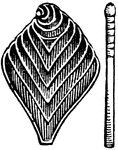
Flabellina rugosa
This illustration shows the calcareous shell Flabellina rugosa. These shells are mostly very small,…
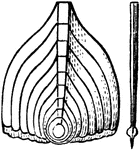
Frondicularia Annularis
This illustration shows the calcareous shell Frondicularia Annularis. These shells are mostly very small,…
Fusulina Cylindrica
This illustration shows the calcareous shell Fusulina cylindrica. These shells are mostly very small,…
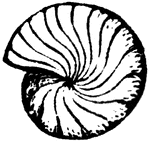
Fusulina Cylindrica
This illustration shows the calcareous shell Fusulina cylindrica. These shells are mostly very small,…
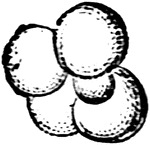
Globigerina Rubra
This illustration shows the calcareous shell Globigerina rubra. These shells are mostly very small,…

Grammostomum Phyllodes
This illustration shows the calcareous shell Grammostomum phyllodes. These shells are mostly very small,…

Limpet
Limpets are found along the shore. they are gastropods with low conical shells. this is a surface view.
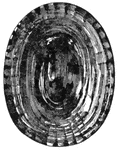
Limpet
Limpets are found along the shore. they are gastropods with low conical shells. This is a side view.

Lingula Antigua
The Lingula antigua is a little bivalve shell belonging at the bottom of the class Brachiopoda. The…
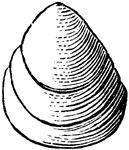
Lingula Prima
The Lingula prima is a little bivalve shell belonging at the bottom of the class Brachiopoda. The inarticulate…
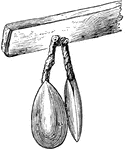
Modern Lingula
Lingula is a genus of brachiopods within the class Lingulata. Lingula is among the few brachiopods surviving…

Lituola Nautiloides
This illustration shows the calcareous shell Lituola nautiloides. These shells are mostly very small,…

Marginella
Marginella is a genus of small sea snails, marine gastropod molluscs in the family Marginellidae, the…

Right Valve of Mollusk
Bivalves are molluscs belonging to the class Bivalvia. They have two-part shells, and typically both…
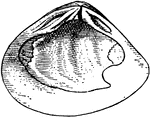
Right Valve of Mollusks
An illustration of the right valve of a mollusk. Bivalves are molluscs belonging to the class Bivalvia.…
Nodosaria Vulgaris
This illustration shows the calcareous shell Nodosaria vulgaris. These shells are mostly very small,…
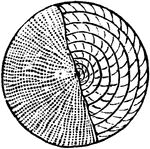
Nummulites Nummularia
This illustration shows the calcareous shell Nummulites nummularia. These shells are mostly very small,…
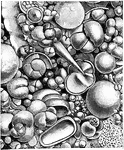
Ooze
"One third of the sea bottom is covered with a soft gray ooze or mud made up entirely of the shells…

Red Whelk
Fusus antiquus. "...a division of prosobranchiate gastropods, having the lip of the shell notched, canaliculate,…
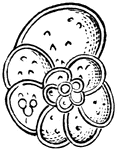
Rotalia Globulosa
This illustration shows the calcareous shell Rotalia globulosa. These shells are mostly very small,…

Coiled Chambered Shell
Goniatites are extinct ammonoids, shelled cephalopods related to squid, octopus, and belemnites, that…
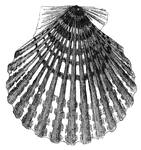
Pecten Shell
Elegant shells ribbed and mottled with various colors. They grow by additins made to the edge.

Coiled Chambered Shell
Baculites is a genus of extinct marine animals in the Phylum Mollusca and Class Cephalopoda. They are…
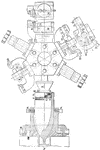
Navy Ordnance Shells
A diagram illustrating the by using a fixed revolver head while spinning the lathe to create the cone…
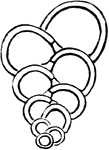
Textilaria Globulosa
This illustration shows the calcareous shell Textilaria globulosa. These shells are mostly very small,…

Triloculina Josephina
This illustration shows the calcareous shell Triloculina Josephina. These shells are mostly very small,…
Wampum Given to William Penn
A wampum is a Native American belt made from shell beads. The wampum pictured was given to William Penn…

